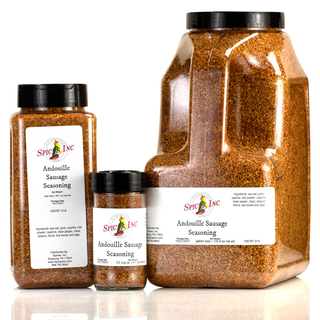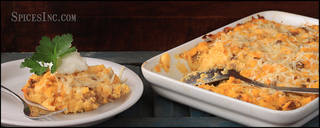Andouille Sausage Seasoning




Andouille Sausage Seasoning
What Is Andouille Seasoning
Andouille, pronounced "an-DOO-ee", is also called andouille sausage seasoning and andouille spice.
Andouille Seasoning brings the lush cuisine of the American South to life. Use this seasoning to make homemade andouille sausage. This garlic-forward blend has some spicy heat from cayenne pepper and chili powder. Mace and allspice add their sweet, woodsy fragrance and biting, peppery and antiseptic qualities.
Andouille Sausage is a smoked pork sausage that originated in Europe. The Cajun version of andouille is typically smoked twice and is commonly used as an ingredient in making several classic dishes. Its signature smoky flavor can be found in etouffee, gumbo, jambalaya and you'll be hard pressed to make an outstanding red beans and rice without it.
How to Use Andouille Seasoning
When making sausage, we recommend 1 1/2-2 Tablespoons of Andouille Sausage Seasoning per pound of meat, since sausage tends to be more intensely seasoned that other dishes.
This is certainly an ideal seasoning blend to use when making andouille sausage, but it can also be used as a dry marinade when prepping a pork shoulder to make pulled pork and can also be easily mixed into meatballs or richly sauced chicken dishes, like Cajun butter chicken. We’ve also used it in a delightful Breakfast Casserole that can be made on the weekend and used for quick weekday breakfasts. It would be a great addition to red beans and rice and is lovely in a Louisiana shrimp pasta. It would be right at home in a Vegetarian Gumbo.
History of Andouille Sausage
While its name and origins are believed to be French, Andouille’s Louisiana roots are in fact German. In the 1700s Rhineland immigrants brought this sausage to Louisiana’s German Coast, called “Côte des Allemands” by the locals. There Andouille was enthusiastically embraced by the Acadians, or Cajuns, of Southern Louisiana1. The strong traditions of making sausage were widespread among the German immigrants but since French was the common language of the area, like many other things, including family names, the sausage was given a French name, andouille. Each family had its own recipe for making andouille as well as different techniques for smoking, all of which were highly guarded by each family and rarely shared2.
As Andouille has become more common there is a debate about whether the sausage originated in France or Germany. A similar meat, Nduja (pronounced en-doo-ya), is popular in Italy. The name seems derived from the French smoked pork sausage andouille and nduja could have come from the French Angevins who conquered Sicily in the thirteenth century3.
Cajun andouille sausage is a quite different version than its distant French cousin. The French version of andouille is made primarily from the pig's stomach and intestines. Cajun andouille relies mostly on smoked pork shoulder. Cajun andouille is mixed with spices such as cayenne, garlic, paprika and thyme. Once the Cajun andouille sausage is stuffed in the hog casing it's typically smoked for a second time.
Along the Mississippi River in Louisiana is a small river town called LaPlace that in the 1970s, then-Governor Edwin Edwards proclaimed LaPlace the "Official Andouille Capital of the World"4. It's no surprise that traditional Louisiana andouille thrives in LaPlace as this riverfront region is often referred to as the German coast because of the large amount of German families that originally settled in the area.
While the southern U.S. andouille tradition is not exclusive to LaPlace the area does seem to have a well-earned reputation for sausage that is heartier, larger, and maybe smokier! LaPlace's artisan sausage makers are obsessed with the smallest of details and are meticulously involved in every stage of production. Their individual grinding, seasoning, stuffing, and smoking recipes and techniques are closely held family secrets that are taught from one generation to the next. The result is a distinctively local andouille style that is chunky and reminiscent of thick German wurst5.
| Ingredients | Sea salt, garlic, paprika, chili powder, cayenne, black pepper, mace, allspice, thyme, bay leaves and sage |
| Recommended Uses | Use to make homemade sausage, or to season pork shoulder, meatballs, pasta and rich creamy sauces |
| Flavor Profile | Packs some heat with noticeable garlic notes and herby undertones |
| Cuisine | Cajun |
| How To Store | Airtight container in a cool, dark place |
| Shelf Life | 6-12 Months |
| Country of Origin | USA |
| Dietary Preferences | Gluten Free, Kosher, Non-GMO |
Hungry for More Information?
What Is the Difference between Cajun and Creole Spices?
Roots of American Cuisine
Three Regional Traditions to Seasoned American Rice
What Is a Sofrito?
References
1 D’Addono, B. (2020, November 24). Along the Andouille Trail. Country Roads Magazine HortScience.
2 Jacob’s Andouille - History page 1. (n.d.). Cajun Sausage. Retrieved January 20, 2022.
3 Chefs, G. I. (2021, July 16). ’Nduja: Spilingaâ’s spicy, spreadable super sausage. Great Italian Chefs. Retrieved January 20, 2022.
4 Mazur, J. (2016, October 14). Why is LaPlace the andouille capital of the world?. WGNO. Retrieved January 20, 2022.
5 LaPlace is “the Place” for Andouill?. (2013, October 17). WWNO. Retrieved January 20, 2022.
Nutrition Facts
Serving Size1 tsp
Amount Per Serving
Calories8
% Daily Value*
Total Fat0g0%
Saturated Fat0g0%
Trans Fat0g
Polyunsaturated Fat0g
Monounsaturated Fat0g
Cholesterol0mg0%
Sodium791mg34%
Total Carbohydrate1.7g1%
Dietary Fiber0.9g4%
Total Sugars0.1g
Added Sugars0g0%
Sugar Alcohol0.0g
Protein0.4g0%
Vitamin D0mcg0%
Calcium2mg0%
Iron0mg1%
Potassium30mg1%
*The % Daily Value (DV) tells you how much a nutrient in a serving of food contributes to a daily diet. 2,000 calories a day is used for general nutrition advice. These values were calculated and therefore are approximate. For more


